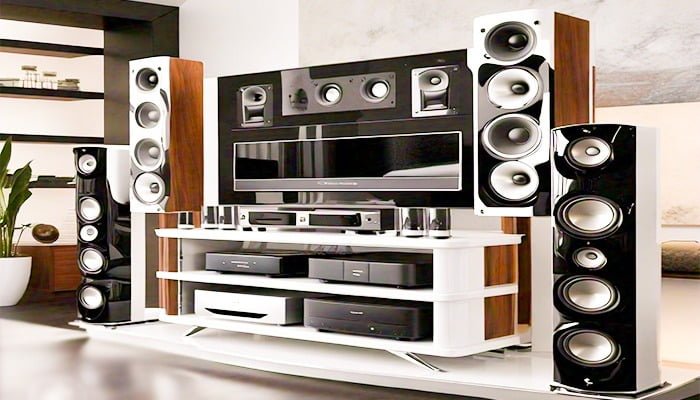Introduction
Imagine a world that isn’t music or being unable to talk over long distances. The audio devices we assume are standard equipment are on the rise in transforming the way we hear sound. From phonographs from the beginning to digital wonders, technological innovation is at the core of the evolution. Let’s explore the fascinating experience of audio technology and learn how technology is continuing to revolutionize our audio experience.
The History of Audio Systems
Early Sound Reproduction
Our journey begins in the early 19th century when Thomas Edison invented the phonograph. It was a device that could create and record sound by using metal foil wrapped around cylinders. Although it was rudimentary, the device set the foundation for the future of technology.
The Advent of Stereo Sound
Moving forward to the late 20th century, stereo audio first came into use. The technology allowed music to be stored and replayed on two channels. This created an immersive experience. Imagine listening to your preferred orchestra and being able to feel like it’s in the front row. That’s the power of stereo.
The Digital Revolution
The end of the 20th century brought the advent of digital technology. CDs (CDs) substituted vinyl records, delivering more clarity and better endurance. Digital audio promises higher quality as well as convenience, setting the way for the next generation of audio technology.
The Science of Sound
Understanding Sound Waves
Sound is a soundwave that traverses mediums such as water, air, and solid substances. , Their amplitude and frequency identify them, and the frequency and volume of the sound that we hear are determined.
The Role of Acoustics
Acoustics is the study of sound. It is the study of the way sound waves react to diverse surroundings. Imagine the way your voice resonates in ample spaces versus in smaller spaces. Acoustics affect the sound.
How Audio Systems Reproduce Sound
Audio devices convert electric signals to sound. Speakers, for example, create sound waves that the ears can interpret. The quality of the sound that is produced will depend on the components of the system as well as the style of the system.
Key Innovations in Audio Technology
The Rise of Digital Audio
Digital audio has changed the way we make and use audio. It provides superior audio quality, better storage as well as better editing features. From streaming players to MP3 players, digital audio services are available all over the place.
Wireless Audio Systems
There’s no need for strangling wires. Wireless audio systems make use of techniques such as Bluetooth and Wi-Fi to transmit audio, allowing for convenience but not losing quality. It is now possible to stream the music you love via your mobile and your speaker without having a cable visible.
Noise-Cancellation Technology
The technology of noise cancellation is revolutionary for people who want tranquility. The technology uses microphones that pick up sounds and produce sounds that block out any unwanted sounds. This is a popular feature for earbuds and headphones.
The Impact of Digital Transformation
The shift between Analog Digital Digital
The change from analog systems to digital is a huge one. Digital technology has clearer audio, is less susceptible to degradation, and is more adaptable. Did you ever remember those radio broadcasts with static? Digital audio has dramatically enhanced the listening experience.
Benefits of Digital Audio Systems
Digital audio systems provide numerous benefits. They have high-quality audio, can be easily customized, and are able to be integrated with various other electronic gadgets. The synergy improves the general user experience.
The Role of Software in Sound Quality
Software plays a vital role in today’s audio systems. It improves the sound quality by adjusting equalization, dynamic range compression, and other techniques for digital processing. The idea is that good software will transform a standard system into an exceptional one.
High-Fidelity Audio Systems
What is High-Fidelity Sound?
High-fidelity (hi-fi) audio is designed to recreate audio as precisely as possible. This translates to minimal distortion, an extensive band of frequency, and an immersive, clear listening experience. Audiophiles are devoted to getting the most pure sound.
Components of High-Fidelity Systems
Hi-fi systems usually include premium amps, speakers, and turntables. Every component plays an essential function in creating a stunning quality sound. Making sure you invest in the right equipment is necessary to enjoy the best audio quality.
Popular Brands and Products
Brands such as Bose, Sennheiser, and Bang & Olufsen are synonymous with premium audio. Their audio products, including headphones and home theater systems, are made to deliver top-quality sound.
Smart Audio Systems
Integration into Smart Home Technology
Intelligent audio systems can be connected to other smart home gadgets. Imagine managing your lighting, music, and thermostat with just a voice. This feature is easy to use and improves the quality of your living space.
Voice-Controlled Systems
Voice assistants such as Amazon Alexa and Google Assistant have changed the way we communicate with audio devices. Now, you can listen to music, receive information about news, and operate smart devices with only your voice.
AI and Machine Learning in Audio
Artificial Intelligence (AI), as well as machine learning, have revolutionized audio systems. AI and machine learning can analyze your habits of listening and recommend new songs, alter audio settings on a dime, and recognize various user preferences.
Portable and Wearable Audio Devices
Evolution of Portable Audio
Portable audio gadgets have advanced significantly, from the Walkman to the iPod. The devices make it possible to take the music you love wherever you go. They have also changed the way we listen to media when we travel.
Wireless Earbuds and Headphones
Wireless headphones and earbuds offer comfort and freedom from wires. Brands such as Apple and the AirPods, as well as Sony with their WH-1000XM line, are at the forefront of providing high-quality wireless audio.
Impact on Lifestyle and Mobility
Wearable and portable audio devices change our daily lives. When you’re exercising, traveling, working from home, or commuting at home, these gadgets give you a unified audio experience that is suited to your needs.
Innovations in Speaker Technology
Evolution of Speaker Design
The design of speakers is advancing from bulky and boxy models to modern, chic designs. Modern speakers don’t just sound great, but they also enhance the decor of your house.
Smart Speakers
Smart speakers, including those like the Amazon Echo and Google Nest, offer excellent sound quality with smart home capabilities. They play music, manage smart home devices, and respond to your inquiries.
Multi-Room Audio Systems
Multi-room audio systems permit users to listen to songs in multiple rooms at once. Systems such as Sonos provide an integrated and seamless control, resulting in a unified sound experience across the home.
The Role of Audio in Entertainment
Enhancing Home Theater Experiences
Audio plays a crucial role in delivering the most immersive experience for home theatre. Surround sound systems, as well as soundbars, improve the sound quality of films and make you feel like you are part of the scene.
Audio in Gaming
Good audio can make a big difference in gaming. Sound effects of the highest quality and music can improve the experience of gaming, giving you an edge when playing competitively.
Virtual Reality and Immersive Sound
Virtual Reality (VR) is heavily dependent on sound to provide an immersive experience. Audio technology in 3D helps enhance VR settings to be more accurate and enhance the experience overall.
Professional Audio Systems
Audio Systems in Broadcasting
Broadcasting is dependent on top-quality audio equipment to provide clear and precise sound to the viewers. The latest developments in the field guarantee that live broadcasts are professional and entertaining.
Innovations in Recording Studios
Recording studios employ the latest technology in order to create quality recordings. From high-end microphones to modern mixing consoles. The advancements guarantee the highest quality sound.
Live Sound Engineering
Live sound engineering is the process of managing audio during live occasions. Innovative technologies like digital soundboards as well as wireless microphones have changed the industry, making live performance more immersive than ever before.
Environmental Considerations
Sustainable Audio Technology
Awareness about environmental sustainability is growing, and so is the need for environmentally friendly audio technologies. Businesses are creating devices that use less energy and make use of environmentally friendly materials.
Energy-Efficient Systems
Power-efficient audio systems cut down on energy consumption without compromising quality. It not only helps save money but also helps the environment.
Eco-Friendly Materials
Utilizing eco-friendly audio devices is becoming widespread. Recycling plastics and bamboo, as well as other eco-friendly products, are used in the creation of high-quality audio equipment.
Future Trends in Audio Systems
Predicting Future Innovations
Future audio technology promises to be exciting, with continual technological advancements in the near future. It is possible to expect greater integration using AI, improved sound quality, and more inventive models.
The Role of AI and AR in Audio
Artificial intelligence (AI) and augmented reality (AR) will transform the way we listen to music. Imagine the possibility of personalized soundscapes, as well as AR experiences that are able to adapt to the environment around you in real-time.
The Potential of Holographic Sound
Holographic sound is a new technology that produces a 3D sound field. It will change how we hear audio and make it more realistic and immersive.
Choosing the Right Audio System
Factors to Consider
In deciding on an audio system, be sure to consider aspects such as audio quality, aesthetics as well as compatibility with other devices, and budget. It is essential to choose an audio system that is compatible with the requirements of your particular situation.
Matching Systems to Environments
Different environments require different audio solutions. An apartment of a small size could benefit from a small soundbar, while a house with a lot of rooms could need a multi-room audio system.
Budget Considerations
The audio systems can be found in an array of prices. Find out your budget, and then choose the ideal option within your budget. Be aware that investing in quality will provide you with long-term peace of mind.
Conclusion
The audio industry changes constantly, fueled by technology and innovations. From the beginning of the phonograph to the present’s sophisticated digital audio systems, it has been excellent. Incorporating these advances can enrich our listening experiences and make audio more immersive, practical, and fun.
FAQs
What’s the distinction between digital audio and analog?
Analog audio utilizes continuous signals to portray sounds, while digital audio transforms sound into data in binary. Digital audio is more precise and is less susceptible to loss.
How does the technology for noise-cancellation function?
The technology of noise cancellation uses microphones that detect background noise and create sound waves that cancel the unwanted sound, resulting in an enunciated listening audio experience.
What are the advantages of audio systems with high fidelity?
High-quality audio systems offer precise audio reproduction with minimal distortion and an extensive frequency range. This results in more enjoyable and pleasurable listening.
What is the best way for smart speakers to connect to other equipment?
Smart speakers connect to other smart devices in the home using Wi-Fi and Bluetooth, which allows you to regulate thermostats, lighting, and other devices using your voice or a smartphone app.
What do I need to think about when purchasing an audio device?
If you are considering purchasing an audio system, take into consideration the quality of sound, compatibility with your equipment, style, and budget. Also, consider the particular needs of the environment you live in.



0 Comments on “The Beat of Innovation: Transforming Sound with Audio Systems”